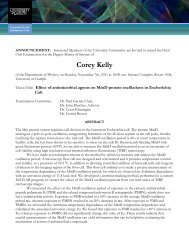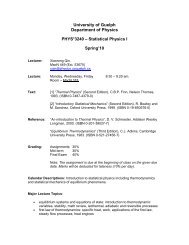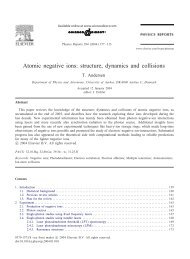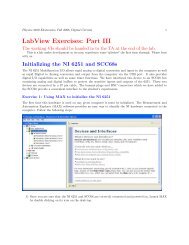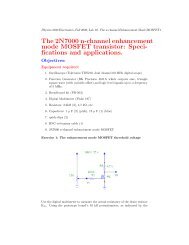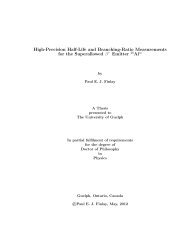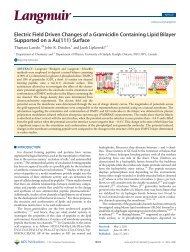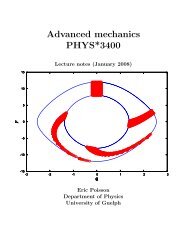Geant4 Simulations for the Radon Electric Dipole Moment Search at
Geant4 Simulations for the Radon Electric Dipole Moment Search at
Geant4 Simulations for the Radon Electric Dipole Moment Search at
Create successful ePaper yourself
Turn your PDF publications into a flip-book with our unique Google optimized e-Paper software.
γ-Ray and Internal Conversion Electron Emission<br />
As described in Section 3.3, <strong>the</strong> γ-decay and internal conversion processes are<br />
competitive. Level structure in<strong>for</strong>m<strong>at</strong>ionisrequired toaccur<strong>at</strong>ely describe <strong>the</strong>ir probabilities.<br />
At any particular excited st<strong>at</strong>e in <strong>the</strong> daughter nucleus <strong>the</strong>re are N number<br />
of γ decays which can popul<strong>at</strong>e lower energy levels. The probability <strong>for</strong> a particular<br />
transition is given by (1+α)I γ /I sum , where α is <strong>the</strong> internal conversion coefficient,<br />
I γ is <strong>the</strong> measured γ-ray intensity and I sum = ∑ N (1+α N)I γN , such th<strong>at</strong> <strong>the</strong> total<br />
decay probability <strong>for</strong> th<strong>at</strong> excited st<strong>at</strong>e is normalized to 100%. Through Monte Carlo<br />
techniques, a decay branch is selected and <strong>the</strong> probabilities of γ decay versus internal<br />
conversion are calcul<strong>at</strong>ed from Equ<strong>at</strong>ions 3.1, and again selected by Monte Carlo.<br />
If <strong>the</strong> selected process is γ decay, <strong>the</strong> energy of <strong>the</strong> emitted γ ray is simply read<br />
from <strong>the</strong> input d<strong>at</strong>a. If <strong>the</strong> selected process is internal conversion, <strong>the</strong> energy of <strong>the</strong><br />
emitted electron is<strong>the</strong> γ-rayenergy minus <strong>the</strong> electron binding energy <strong>for</strong> <strong>the</strong>electron<br />
shell. The shell is determined from <strong>the</strong> probabilities given from <strong>the</strong> individual shell<br />
internal conversion coefficients. Atomic electron binding energies [49] were directly<br />
coded into <strong>the</strong> <strong>Geant4</strong> simul<strong>at</strong>ion, resulting in accur<strong>at</strong>e internal conversion electron<br />
energies <strong>for</strong> shells K to N, and a general code th<strong>at</strong> can be used in cases o<strong>the</strong>r than<br />
<strong>the</strong> 223 Rn to 223 Fr decay studied here.<br />
X-ray Emission<br />
Following <strong>the</strong> emission of an internal conversion electron <strong>the</strong>re exists a low lying<br />
vacancy in <strong>the</strong> <strong>at</strong>omic shell structure of <strong>the</strong> daughter <strong>at</strong>om ( 223 Fr). An electron in a<br />
higher orbital will prefer to occupy this lower energy st<strong>at</strong>e. As it transitions into <strong>the</strong><br />
vacancy energy is released in <strong>the</strong> <strong>for</strong>m of a X ray.<br />
The simul<strong>at</strong>ion of <strong>the</strong> X-ray emissions had two main user options. The first option<br />
46



